The Association for Mormon Letters’ AML Awards were presented online on July 20, 2024. You can watch the awards ceremony, emceed by Jeanine Bee, and featuring remarks from many of the winners, at Youtube here. You can also see many of the award winners reading from their award-winning works at the end of the video. Below is each award winner, along with the award citation written by the judges.
Shannon Hale was presented with the Smith-Pettit Foundation Award for Outstanding Contribution to Mormon Letters. Carol Lynch Williams and Chris Crowe were presented with Association for Mormon Letters Lifetime Achievement Awards. See the links for the award citations and links to their interviews.
 Comics
Comics
Anna M. Wright. Apos
Anna M. Wright presents a thought-provoking and thoughtful exploration of faith in Apos. Wright uses the inherent and unique strengths of the comic book medium to tell a brief but powerful story of a recently returned sister missionary struggling to adjust to her new life, and reflecting on her mission experiences, a chapter of a larger work-in-progress.Apos is evidence of Wright’s significant skill in storytelling craft, as well as deftness in addressing deep and personal subject matters.
Other finalists:
Brittany Long Olsen. Are You My Mother?
Norman Shurtliff. Skull Cat and the Curious Castle
Criticism
Mason Kamana Allred. Seeing Things: Technologies of Vision and the Making of Mormonism. University of North Carolina Press
and
Gavin Feller. Eternity in the Ether: A Mormon Media History. University of Illinois Press
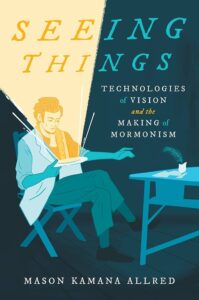 These books read like two halves of the same story, so it felt natural that they should receive this award together. By reading both, the reader gets a comprehensive vision of how Mormon beliefs and practices intersect with media technologies, with Seeing Things focused more on the nineteenth and early twentieth centuries and Eternity in the Ether picking up with the invention of radio and going into the early twenty-first century.
These books read like two halves of the same story, so it felt natural that they should receive this award together. By reading both, the reader gets a comprehensive vision of how Mormon beliefs and practices intersect with media technologies, with Seeing Things focused more on the nineteenth and early twentieth centuries and Eternity in the Ether picking up with the invention of radio and going into the early twenty-first century.
Seeing Things has a strong literary style that can be rare in works of criticism—we loved the analogy of ghosts that tied all of the chapters together. Added to this is a deep understanding of the theoretical foundations of the subject and a clear presentation of the historical context of lost media technologies. The specific pieces that Allred chooses to analyze are intriguing in their own right while also providing a strong, continuous narrative of the unique way Mormon theology engages with the material and the visionary.
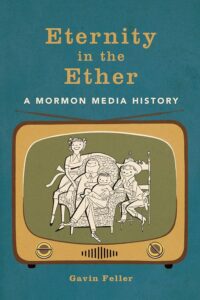 Eternity in the Ether provides detailed archival work as well as interviews that chart new terrain in our understanding of the Church of Jesus Christ of Latter-day Saint’s adoption of mass media technologies. The detailed behind-the-scenes look at the rise of the Mormon media machine provides context for how Church media became what it is today as well as a glimpse of alternate paths not taken. Feller ties these stories to a greater historical perspective, putting forward Mormon media history as relevant to American religious and media studies as a whole. We believe that together these books provide an essential and unique framework for future studies of Mormon media, culture, and literature.
Eternity in the Ether provides detailed archival work as well as interviews that chart new terrain in our understanding of the Church of Jesus Christ of Latter-day Saint’s adoption of mass media technologies. The detailed behind-the-scenes look at the rise of the Mormon media machine provides context for how Church media became what it is today as well as a glimpse of alternate paths not taken. Feller ties these stories to a greater historical perspective, putting forward Mormon media history as relevant to American religious and media studies as a whole. We believe that together these books provide an essential and unique framework for future studies of Mormon media, culture, and literature.
Other finalists:
Michael Austin and Rachel Meibos Helps. “‘The Gospel of Intelligence and Culture’: Literature and Literary Instruction in the Twentieth-Century MIA Curriculum”
Stephen Carter.Virginia Sorensen: Pioneering Mormon Author
Nicholas J. Frederick. “Could Brandon Sanderson Have Saved the Nephites?”
Special Award in Children’s Literature
Josh and Sarah Sabey. Illustrated by Maddie Baker. The Book of Mormon Storybook. Independently published.
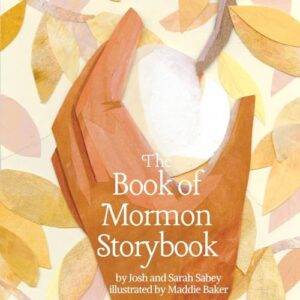 The Book of Mormon Storybook is a landmark achievement and a standout offering in the world of children’s Book of Mormon adaptations. Accessible and gentle enough for children while still being genuinely thought-provoking and moving, the two volumes in this series are those rare children’s books worth owning, reading, and re-reading. As a physical object, the set is beautiful and high-quality, lovely to hold in your hand, with beautiful collage-style illustrations and text large enough for easily reading aloud. The stories and illustrations highlight characters who are often overlooked (like women and children) and movingly emphasize the divine humanity of every individual. Evident in these retellings is the authors’ hard-won belief that each person in every story is a real person with real experiences and real emotions. The stories are skillfully written and thematically cohesive, effectively demonstrating how the Book of Mormon points to a loving God and works as an antidote to modern polarization and despair. The authors offer intriguing insights based on thorough theological research and an obvious deep love for the Book of Mormon, its authors, and its readers. Importantly, this collection does not present itself as the final authoritative reading of the text, but rather as a jumping off place for starting conversations. It is an invaluable resource for anyone looking to re-encounter a familiar text with new eyes, and highly recommended to individuals and families of all ages.
The Book of Mormon Storybook is a landmark achievement and a standout offering in the world of children’s Book of Mormon adaptations. Accessible and gentle enough for children while still being genuinely thought-provoking and moving, the two volumes in this series are those rare children’s books worth owning, reading, and re-reading. As a physical object, the set is beautiful and high-quality, lovely to hold in your hand, with beautiful collage-style illustrations and text large enough for easily reading aloud. The stories and illustrations highlight characters who are often overlooked (like women and children) and movingly emphasize the divine humanity of every individual. Evident in these retellings is the authors’ hard-won belief that each person in every story is a real person with real experiences and real emotions. The stories are skillfully written and thematically cohesive, effectively demonstrating how the Book of Mormon points to a loving God and works as an antidote to modern polarization and despair. The authors offer intriguing insights based on thorough theological research and an obvious deep love for the Book of Mormon, its authors, and its readers. Importantly, this collection does not present itself as the final authoritative reading of the text, but rather as a jumping off place for starting conversations. It is an invaluable resource for anyone looking to re-encounter a familiar text with new eyes, and highly recommended to individuals and families of all ages.
Creative Nonfiction
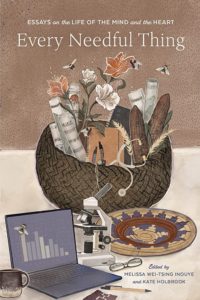 Melissa Wei-Tsing Inouye and Kate Holbrook, eds. Every Needful Thing: Essays on the Life of the Mind and Heart. Maxwell Institute
Melissa Wei-Tsing Inouye and Kate Holbrook, eds. Every Needful Thing: Essays on the Life of the Mind and Heart. Maxwell Institute
This wide-ranging essay collection, edited by Melissa Wei-Tsing Inouye and Kate Holbrook, corrals together the personal voices and stories of LDS women from all across academia, business, and law. Each of these brilliant women opens up about her own personal journey navigating faith and reason, love and law, and embracing the full complexity of our God-given world. Whereas previous generations of Church members might have perceived an irreconcilable tension between so-called “worldly” pursuits and a woman’s so-called “divine role,” this collection put out by Deseret Book goes a long way towards normalizing within the Church the assumption that a woman’s proper place is to be a leader in her field.
Other finalists:
Joshua Foster. The Clean Package: A Pioneer Assemblage
D. Michael Quinn. Chosen Path: A Memoir
Drama
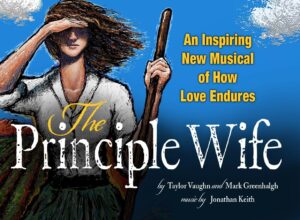 Taylor Vaughn and Mark Greenhalgh (book and lyrics), Jonathan Keith (music). The Principle Wife. Covey Center, Provo, July 2023
Taylor Vaughn and Mark Greenhalgh (book and lyrics), Jonathan Keith (music). The Principle Wife. Covey Center, Provo, July 2023
The Principle Wife tackles an artistically under-explored time in Mormon history–the end of polygamy, based on a true story of early Latter-day Saints. The musical uses big emotions, meaty roles, and surprising heft to tell a thorny story of a polygamous family, taking place over many years, and filled with natural, largely realistic, conflict. The musical draws on popular, blockbuster-style musical stylings, largely wields them to good effect, and is filled with well-drawn characters, especially two of the wives–Rebecca and Sarah. The story also involves an outsider that knows Rebecca from before her conversion, introducing additional productive complexities. The playwrights shy away from some of the more complicated possibilities of its premise as it concludes, perhaps too neatly tying up rich dynamics of dissatisfaction on display earlier in the play. Yet, The Principle Wife entertains with believable, memorable dialogue and keeps the audience engaged, unsure about where this story is going until the final moments. May Mormon drama and the Mormon arts follow The Principle Wife‘s example of pursuing underexplored periods and themes, focusing on rich interpersonal dynamics, and blending blockbuster/pop-stylings with high craftsmanship to do so.
Other finalists:
Melissa Leilani Larson. The Orphanage
Debora Threedy. Mountain Meadows
Charlotte Westover (book, lyrics, music). Hattie’s Echo
Film
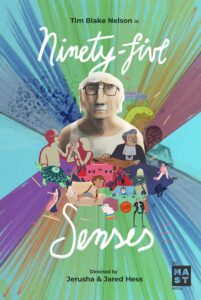 Ninety-Five Senses. Jared and Jerusha Hess, directors. Chris Bowman and Hubbel Palmer, screenwriters
Ninety-Five Senses. Jared and Jerusha Hess, directors. Chris Bowman and Hubbel Palmer, screenwriters
From arguably the most eminent filmmakers to emerge from the Mormon tradition, Ninety-Five Senses reminds us what elevates the work of Jerusha and Jared Hess to another level, and leaves a profoundly spiritual impact. On a technical level alone, the film is a masterpiece. Having various animators represent the five human senses is a brilliant way to let the tapestry of the work itself embody the diversity of physical experience.
Tim Blake Nelson delivers an understated but moving performance as the everyman Coy. The film carefully reveals Coy’s character, and the sin he is about to pay for. The piece interrogates death by reminding us of life, and teaches us not to relegate others into binary boxes. For Jared and Jerusha to step so comfortably away from humor into a warm, dramatic piece is noteworthy.
On a personal note, I recently had the opportunity to speak with Jerusha about the project, and was moved by the sheer weight of empathy she exudes. Her film is perfectly compassionate, and demonstrates grace, atonement, hope for the beyond, and the celebration of a mortal body in ways that are difficult to put into words. It is significant to me that even in Jerusha’s stated departure from organized religion, her film still beautifully embodies a universal spiritually so familiar to a Latter-day Saint, perhaps even more than it might otherwise. It is, in my opinion, the Hess’ most transcendent work. (Citation by Barrett Burgin)
Other finalists:
Aliens Abducted My Parents and Now I Feel Kinda Left Out. Jake Van Wagoner, director. Austin Everett, screenwriter.
The Handbook. Brandon Carraway, director and screenwriter, Hannah Grace Carraway, screenwriter.
I Have No Tears, and I Must Cry. Luis Fernando Puente, director and screenwriter.
Patience. Chantelle Squires, director. Melissa Leilani Larson, screenwriter.
Middle Grade Novel
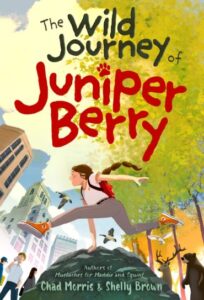 Chad Morris and Shelly Brown. The Wild Journey of Juniper Berry. Shadow Mountain
Chad Morris and Shelly Brown. The Wild Journey of Juniper Berry. Shadow Mountain
Plucky Juniper Berry knows all about the constellations and the stories behind them. She knows how to fox-walk up to a grazing deer so it doesn’t flinch. And she can shoot an arrow so accurately that she misses just to scare her sister. But her life in the forest —the only life she knows — comes to a frightening end when her brother gets sick and her family rushes out of the woods and back to civilization and a family her parents had chosen to abandon long ago. Juniper Berry is thrust into a world that makes no sense – a box that does laundry, hot water that comes out of a wall, and a school where her abilities to jump and climb are not appreciated. Her cousin is embarrassed by her, and her sister has become one of them. What’s more, her family does not have money to pay her brother’s hospital bills, and Juniper needs to figure out how to earn money — and a lot of it. If she doesn’t get the money, she may have to stay in this crazy society forever!
It turns out that Juniper’s unique knowledge combined with 21st century tools might be exactly what she needs to help her family. But she has to survive civilization first.
Chad Morris and Shelly Brown have created a delightful fast-paced story that takes the reader on a truly wild journey with Juniper Berry, from life living on the land to the challenges of civilized junior high school. Young readers will love Juniper’s scrappy nature and blunt honesty. They will relate to how hard it can be to fit in with other kids — who are also trying to fit in — and they will cheer as Juniper rises to meet her challenges with a little help from unexpected places.
Other finalists:
Chad Morris and Shelly Brown. Virtually Me
Sandra Soderborg. Sky Ropes
Mike Thayer. The Talent Thief
Elaine Vickers. Half Moon Summer
Novel
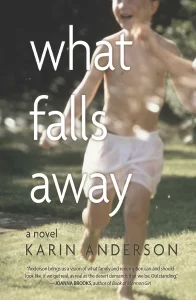 Karin Anderson. What Falls Away. Torrey House
Karin Anderson. What Falls Away. Torrey House
As timely as ever in our social, political, and religious climate, Karin Anderson’s What Falls Away depicts within the microcosm of a small Utah town the pernicious results of patriarchy and fundamentalism, where even those who wield their authority to maintain the status quo are casualties of their own repressive system. Each vividly drawn, unforgettable character bears old scars and fresh wounds: A returning daughter, once ostracized, perceived as an immoral contagion; an obedient mother processing years of repression and trauma in tears; a runaway transgender child disappearing into silence; and a proud, unyielding patriarch whose violent end prompts questions with no answers. Karin Anderson’s What Falls Away suggests that any inheritance fostering divisiveness and hatred should be rejected so as to bring healing and unity into the present.
Ironically, then, this novel is sure to attract both those who celebrate its final message of radical acceptance and expansive forgiveness, as well as those who may feel uncomfortable with or resistant to its fierce critique and sharp portrayals of certain LDS cultures, doctrines, and characters. In this way, it does what realist novels do best: condense, compound, and amplify vast swaths of human experience (in this case, very Mormon human experiences) in order to imagine something new, more potent, and more meaningful than the sprawling minutiae that constitutes most of our daily reality. As critic James Wood says, “Fiction is both artifice and verisimilitude, and . . . there is nothing difficult in holding together these two possibilities.” As Latter-day Saints, we can both see ourselves and our communities–sometimes clearly, sometimes uneasily–in Anderson’s harrowing story of a religious upbringing gone wrong, as well as marvel, as we do when we see a great painting or sculpture, at how much more [fill in the blank] it is than our own lived experience would allow. Verisimilitude and artifice; Anderson offers us both in full measure. It is a book, like the best religiously-themed novels, that transcends its overtly sectarian subject matter and speaks to a wider audience for whom fiction serves to connect richly-rendered and idiosyncratic characters to the universal questions and impulses that lurk in every human heart.
Other finalists:
John Bennion. Ruth at the End of the Earth
Theric Jepson. Just Julie’s Fine
Sheldon Lawrence. Heaven Will Find You
Picture Book
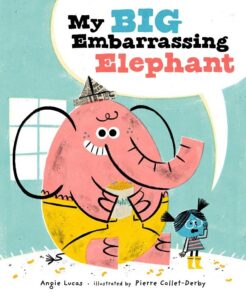 Angie Lucas. Illustrated by Pierre Collet-Derby. My Big Embarrassing Elephant. Marble Press
Angie Lucas. Illustrated by Pierre Collet-Derby. My Big Embarrassing Elephant. Marble Press
Mac Barnett once said that it’s easy to write a picture book but hard to write a good one. A good picture book makes it look easy, and My Big Embarrassing Elephant is an excellent picture book.
On the surface, the story is about a girl with a stinky elephant at home. Children will laugh as they see the sister literally dancing around the elephant or the mom sweeping the elephant under a dusty rug. But the story is much more than that; the writing and illustrations work together perfectly to tell a story that works on multiple levels. For children living with difficult or embarrassing situations at home, they’ll see their own circumstances in the girl’s attempts to hide the elephant from neighbors and potential friends.
This is a hopeful story—and a helpful one, teaching both children and adults that you’re not alone in your struggles and don’t need to hide. As the author herself says, “Sunlight is the best antidote to shame.”
Other finalists:
Amy June Bates (author and illustrator). The Welcome Home
Susan Evans McCloud. Illustrated by Alexandra Bulankina. Jesus Once Was a Little Child
Heidi Poelman. Illustrated by Angie Alape. Women in Science Who Changed the World
Elaine Vickers. Illustrated by Ana Aranda. How to Make a Memory
Podcast
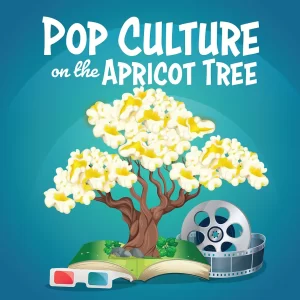 Pop Culture on the Apricot Tree. Liz Busby and Carl Cranney
Pop Culture on the Apricot Tree. Liz Busby and Carl Cranney
The Association for Mormon Letters supports literature that is “by, for, and about Mormons.” If we isolate those three poles, we find that much has been written about literature that is “by” or “about” Mormons. However, the question of what it means for literature to be “for” Mormons, i.e., what it means to engage with something as a Mormon audience, has sometimes been harder to grasp.
The creators of Pop Culture on the Apricot Tree turn that question on its side, by instead asking: What if everything was made for us? The hosts and guests never claim to speak for all Mormons, but their project inherently presupposes that Mormonism (our doctrine, culture, and values) is a worthy lens through which to view and analyze all media. Pop Culture on the Apricot Tree is ultimately an invitation to fellow Mormons to approach media not reductively, but expansively.
Other finalists:
Angels and Seerstones: A Latter Day Saint Folklore Podcast. Christopher James Blythe and Christine Elyse Blythe.
Exponent II: The Podcast. Ramona M., Heather Sundahl, and Carol Ann Litster Young.
Follow: A Latter-day Saint Poetry Podcast. Merrijane Rice.
Post-Mormon at the Movies. Dan McIntosh and Nick Thacker.
Poetry
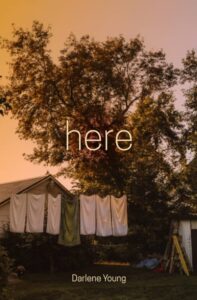 Darlene Young. Here. BCC Press
Darlene Young. Here. BCC Press
Darlene Young’s poetry in Here is visceral and true–in part because the subject matter itself is so real, but also due to her adept use of form and image and turns of phrase. She casts new light on relatable everyday subjects as well as familiar religious stories (such as the brilliant and devastating “Tower of Babel”), illuminating their true depth. In her own words, “It’s worthwhile to learn about something you love / from a different angle.” (p. 11) Even subjects such as motherhood that, in other hands, may feel overwrought or cliche are masterfully lampshaded (p. 75). Young’s poems speak to the messy, celebratory joy of living in these beautiful broken bodies of ours, in a way that feels very Mormon but also deeply relatable to others as well.
Other finalists:
Susan Elizabeth Howe. Infinite Disguises
Dayna Patterson. Oh Lady Speak Again
Religious Nonfiction
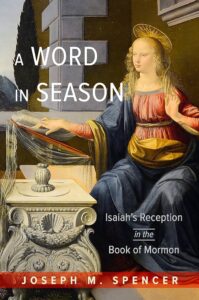 Joseph M. Spencer. A Word in Season: Isaiah’s Reception in the Book of Mormon. University of Illinois Press
Joseph M. Spencer. A Word in Season: Isaiah’s Reception in the Book of Mormon. University of Illinois Press
Readers of the Book of Mormon have long known of its intimate relationship with the Bible. More than a few authors have catalogued the presence of the King James translation in the nineteenth-century book, usually framed as “plagiarisms.” Spencer, and a scattering of other scholars, have emerged to help us reconsider the complexity of this relationship. While less thoughtful voices have asserted that Isaiah’s prevalence in the Book of Mormon is to emphasize the important of the Old Testament book or more cynically to fill space, Spencer shows how different narrators use Isaiah for their own purposes. These intertexts, as Spencer ably demonstrates, move forward the book’s narrative, reveal ruptures in Book of Mormon societies, provide apocalyptic commentary, and ultimately even considers its own importance as a future book.
Seasoned readers of the Book of Mormon will find much to ponder alongside Spencer. And, certainly, those devout readers will be the primary audience for A Word in Season; however, Spencer’s work deserves to be recognized as an indispensable volume in Mormon Studies generally. Future studies of Joseph Smith’s scriptural production would be incomplete without considering Spencer’s insights.
A Word in Season: Isaiah’s Reception in the Book of Mormon is a highly readable, deeply thoughtful and well-argued consideration of Isaiah’s presence in the Book of Mormon. It is a welcome testament to the advancement of the field of Book of Mormon Studies and to its author, Joseph Spencer, as one of the leading voices in Latter-day Saint scriptural interpretation today.
Other finalists:
Grant Hardy. The Annotated Book of Mormon
Eric D. Huntsman and Trevan G. Hatch. Greater Love Hath No Man: A Latter-day Saint Guide to Celebrating the Easter Season
Benjamin Keogh, Joseph M. Spencer, Jennifer Champoux, eds. Approaching the Tree: Interpreting 1 Nephi 8
Taylor G Petrey, Cory Crawford, Eric A. Eliason, eds. The Bible and the Latter-day Saint Tradition
Special Award in Religious Nonfiction
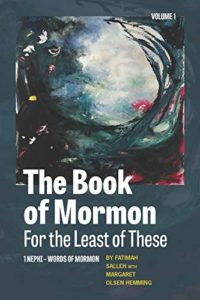 Fatimah Salleh and Margaret Olsen Hemming. The Book of Mormon for the Least of These, volumes 1-3. BCC Press
Fatimah Salleh and Margaret Olsen Hemming. The Book of Mormon for the Least of These, volumes 1-3. BCC Press
This trilogy breaks new ground with its insightful, fearless theological approach, and for being crafted by two extraordinary women—a rare and significant achievement in the world of scriptural commentary.
The series not only dives deep into the Book of Mormon, over three meticulously researched and written volumes, but also connects its teachings to today’s most pressing social issues, including racism, sexism, immigration, and economic inequality. It challenges traditional interpretations and invites readers to explore the scripture’s inherent richness and relevance to modern life, wherever that life is being lived. This approach encourages thoughtful and compassionate engagement, making these volumes essential reading for anyone seeking a deeper understanding of the Book of Mormon.
One standout feature of this series is its ability to humanize the authors of the Book of Mormon, highlighting their fallibility and the cultural contexts in which they wrote. This perspective demystifies the scripture and makes its teachings more relatable and applicable to our lives. By acknowledging the imperfections and humanity of its authors, Salleh and Hemming invite readers to engage with the text critically yet compassionately.
Whether you are a lifelong member of the faith or new to the Book of Mormon, it offers a fresh and essential perspective that will enrich your understanding and appreciation of this sacred text.
Short Fiction
Steven L. Peck. “Sister Carvahlo’s Excellent Relief Society Lesson.” In The Path and the Gate: Mormon Short Fiction
Steve Peck’s story “Sister Carvahlo’s Excellent Relief Society Lesson” is superb. Like all the best stories, this one starts strong, proceeds with unexpectedly appropriate speed through escalation and crisis, and ends in transformation. Peck takes a situation that is all too familiar in our congregations today—how easily we become divided into hostile camps in our wards (over politics, supporting two separate products, or such issues as masks/no masks during COVID)—and presents through his story how inflated and silly our animosity towards each other is. He invents Sister Carvahlo and her husband, a nonmember couple moving into Pleasant Grove, who are confused with a couple that are actually members of the Church and brings them into a ward that gives them the responsibilities of Sunday School president and Relief Society teacher. When animosity arises that brings two factions of the Relief Society into bitterness and acrimony, Sister Carvahlo gives them a lesson that helps them realize how inflated and petty their grievances against each other are. One judge said the story, “not only fully engaged this judge’s intellectual appreciation of literary capability, but also touched her heart deeply enough to make her weep.” “Sister Carvahlo’s Excellent Relief Society Lesson” is masterfully written and imagined, and well deserves the 2023 Association for Mormon Letters Award in Short Fiction.
Other finalists:
Lee Allred. “Four and Seven”
Joe Plicka. “Natural Causes”
Lee Ann Setzer. “Compassed About”
Mathilda Zeller. “The Haunted”
Special Award in Short Fiction
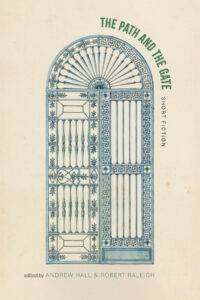 The Path and the Gate: Mormon Short Fiction. Andrew Hall and Robert Raleigh, editors. Signature Books
The Path and the Gate: Mormon Short Fiction. Andrew Hall and Robert Raleigh, editors. Signature Books
It might be enough merely to quote from the earnest and informative introductions by the two editors of this most excellent collection, so worthy of a special award because of the consistently inspiring content and craft of every individual story within it:
From Andrew Hall: “Good stories can benefit from having a prompt: a roadmap with goals and potential rewards. We gave the authors of this collection [a passage from the Book of Mormon–2 Nephi 31: 17-21–] and asked them to write a ‘Mormon story.’ The authors responded with a wide range of tales; some realistic; others fantastic….Taken together, these stories display the vast expanse of experiences and opportunities in a universe encoded with diversity and free will….It is a comfort to have a roadmap, but what really excites me is to see how that roadmap can lead to limitless destinations.” (viii)
From Robert Raleigh: “[This] collection [is] evidence that Mormonism has left its imprint on the ‘world,’ not just as a religion but as a cultural force, and that the directions of its cultural expressions…[show] us how to use our own inner compasses to find our way through the modern landscape.” (ix)
We would add to these declarations of success by pointing not only to variety and effectiveness of content, but to genuine originality and brilliance of craft in these 23 stories. Each one demonstrates a mature distinct voice, a finely-honed take on Mormon principles and practices, and mastery of structure and form so deserving of praise that we could give each one an individual star-studded award—and so we must give a collective one here, appreciating in combination the fine work of the editors in bringing together so many varied, pleasurable, and highly effective pieces of short fiction. This collection is exemplary. We are pleased to acknowledge both editors and every author included herein with this award.
Young Adult Novel
 Brandon Sanderson. Tress of the Emerald Sea. Dragonsteel/Tor
Brandon Sanderson. Tress of the Emerald Sea. Dragonsteel/Tor
When master storyteller Brandon Sanderson pens a fantastical pirate adventure, you expect it to be a lot of things: magical, imaginative, exciting, and unique. Tress of the Emerald Sea is all of these, but it’s also so much more. Our intrepid heroine, Tress, is an ordinary young woman who lives an unremarkable life on a lonely island. When she learns that Charlie—who’s more than just her best friend—is in danger somewhere on the vast spore sea, she springs into action. Drawing on courage she never realized she had, she stows away on a merchant vessel, learns it’s captained by a bloodthirsty pirate, takes on the ship’s most dangerous job, uncovers a sinister onboard plot, and soon finds herself on a quest to find and defeat an all-powerful Sorceress in order to save Charlie, herself, and the crew members who don’t want to be pirates. While the plot may not sound all that original, it’s Sanderson’s creative brilliance that elevates the tale from ordinary to anything but. Like Tress herself, the story contains hidden layers of depth and charm. The tongue-in-cheek narration gives the yarn a delightful Princess Bride-ish vibe that promises a fun, upbeat reading experience right from the get-go. While Tress is an understated heroine, her selfless compassion, humble demeanor, quiet courage, and hidden strength make her admirable and appealing. A supporting cast of entertaining characters (including a talking rat and an undead medical officer) adds humor, conflict, and variety. The rousing, rollicking plot keeps the reader’s interest piqued through all of the book’s 365 pages. While there is some heartbreak to be found within its pages, Tress of the Emerald Seais a happy read that radiates warmth and heart. This entertaining tale will leave a smile on readers’ faces while enchanting them through and through.
Other finalists:
Rosalyn Eves. An Improbable Season
Martine Leavitt. Buffalo Flats
Elizabeth Lowham. Beauty Reborn
Kasie West. Borrow My Heart
